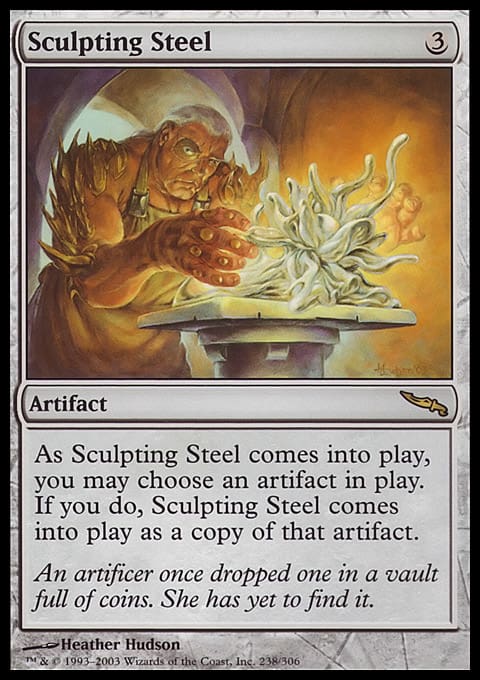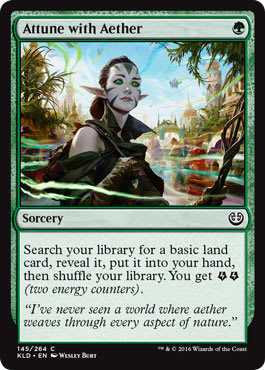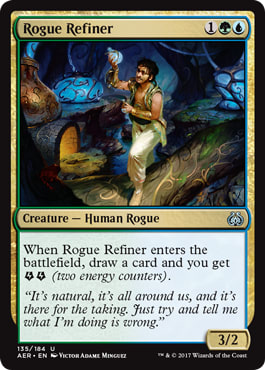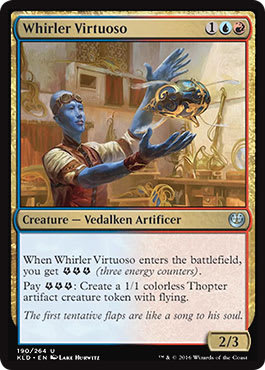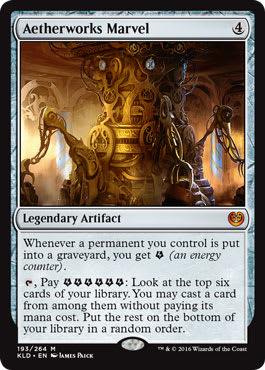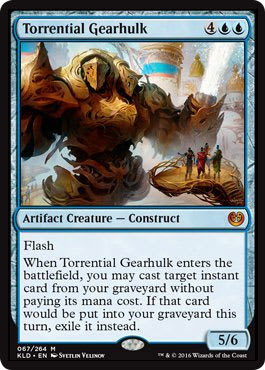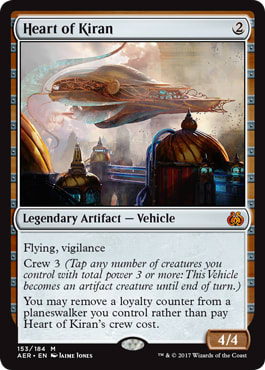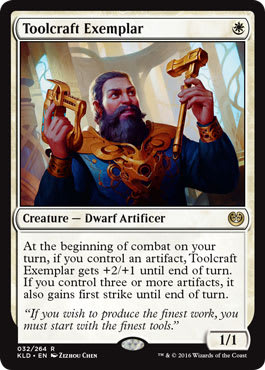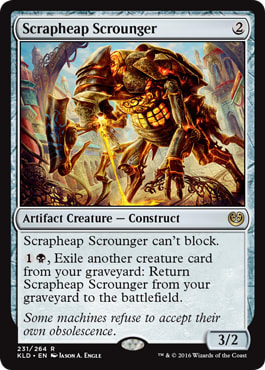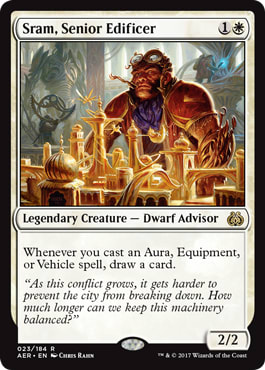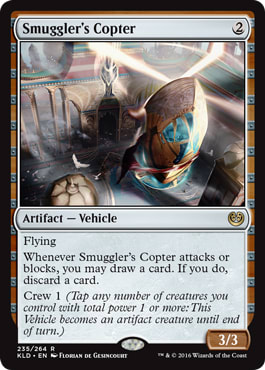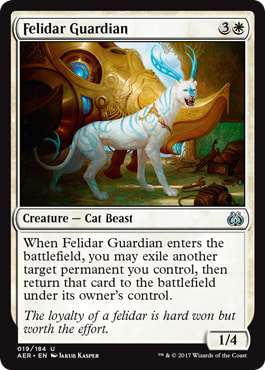When Historic was first announced, the reaction was lukewarm. Modern was already entrenched as the most popular non-Standard format, old folks loved Legacy, and Pioneer was still very new. While there needed to be something to do with your cards once they rotated out of Standard on MTG Arena, not working toward one of the already established formats was confusing. It got even more confusing when they started adding curated cards directly to the format that didn't really follow any known format or pattern. Did you know Captain Sisay was legal in Historic?
However, after a number of these Historic Anthology releases as well as Jump Start and curated cards added into Amonkhet Remastered, Historic has fast become one of the most popular formats in Magic. Part of this is of course due to paper Magic being on an extended break thanks to COVID-19 and the popularity of MTG Arena, but the fact is that Historic is here to say.
And now, it has its "newest" release!
Kaladesh Remastered
Kaladesh Remastered is almost here, returning us to the world of inventions and fast cars. Kaladesh, like most artifact sets before it, was pushed to the limit as far as power level was concerned, which led to multiple bannings in Standard (and was around the start of bannings being so in vogue in Standard).
And now we get to go back!
Like Amonkhet Remastered, Kaladesh Remastered is a mixed set of both Kaladesh and Aether Revolt culled down into one big set. It is meant to both be drafted and provide cards for Historic, but does not contain every card in both of those sets. Furthermore, Amonkhet Remastered also introduced 14 cards into Historic that were not actually in Amonkhet or Hour of Devastation like Thoughtseize and Collected Company which have had a huge impact on the format.
Kaladesh Remastered only has one of these, and while Sculpting Steel is a fun reprint it probably isn't making any major waves in Historic.
But don't fret! There was a ton of power in Kaladesh, which means there are a number of cards that are poised to make an impact. Today we're going to go over what cards stand to make the most noise.
Kaladesh means the return of energy, the parasitic mechanic that was pushed a little too hard and dominated Standard for so long that it saw multiple cards banned. Yes, they banned Lay of the Land in Standard!
However, while Temur Energy was almost the perfect Standard deck, it certainly lacks the raw power to dominate a much more powerful format like Historic. Energy has never touched Modern, and was only a minor player at various points in Pioneer. The rate on cards like Rogue Refiner and Whirler Virtuoso just isn't enough in high power level formats.
The only fair energy card that may have a chance in Historic as a sort of Dark Confident replacement is Glint-Sleeve Siphoner. Even with just a small Attune with Aether/Aether Hub package Glint-Sleeve Siphoner looks pretty nice, and Harnessed Lightning could also have a role here.
Still, energy in general feels fairly fringe because it doesn't really play well with anything else. There are no energy cards in any other set nor are there any energy cards coming down the pipe, which makes playing Kaladesh Block Constructed in a format as powerful as Historic not an exciting proposition.
Of course, there is one very big exception to the energy equation. Aetherworks Marvel, banned in Standard and one of the most hated cards in recent memory, returns as well.
While the fair energy cards don't do much beyond just playing more energy cards, Aetherworks Marvel gets to play with whatever the biggest and dumbest thing available in the format is. And thanks to the Historic Anthologies, that big baddie is none other than Ulamog, the Ceaseless Hunger. Turn Four Ulamog, the Ceaseless Hunger tends to end games very quickly, but it is no guarantee of course. Again we can look to Pioneer to get an idea of what things might look like, where Aetherworks Marvel also was unable to gain much traction.
The best Aetherworks Marvel decks in Standard could put Emrakul, the Promised End in play on turn four, but also played an excellent fair game plan that rivaled what most energy decks were capable of. This fair game probably won't be powerful enough in Historic, while the "turn four Ulamog" plan many not be consistent enough.
Okay, enough about energy.
Angel of Invention and Refurbish aren't super exciting, but there's one card from Amonkhet Remastered that makes them both very interesting: God-Pharaoh's Gift.
Angel of Invention is one of the best possible cards to return with God Pharaoh's Gift, as it can be a 6/6 flying, lifelink, haste, vigilance flyer that can't be Fatal Pushed or Eliminated, or make tokens in a pinch if you need extra blockers. It's also castable in a pinch. Likewise, Refurbish allows you to really push the self-mill cards and skip the Gate to the Afterlife step by putting God-Pharaoh's Gift directly onto the battlefield from your graveyard.
God-Pharaoh's Gift decks have been fringe in Historic, but either of these may change that.
Speaking of Fatal Push... Fatal Push is back!
Fatal Push is one of the best Black removal spells in any format and will be a welcome addition to Historic. While Historic doesn't have fetchlands to fully power it up, Pioneer has shown us that Fatal Push is still a phenomenal Magic card even without them.
There's not much else to say, Fatal Push is a huge addition to Historic.
Another one of the most powerful cards in Kaladesh that was a major player in Standard and has made an impact in both Modern and Pioneer, Winding Constrictor is quite the addition to Historic. While energy seems a bit underpowered for the format, if it does make an impact it is likely that Glint-Sleeve Siphoner, Longtusk Cub, and Winding Constrictor are involved.
But that's not all. We've seen Hardened Scales do a lot of damage at various times in Magic's history across Modern and Pioneer, and Winding Constrictor is cut from the same cloth. Furthermore, it joins Conclave Mentor to provide some redundancy for a potential +1/+1 counters deck.
There is a ton of potential and power in Winding Constrictor.
Hello old friend!
When it comes to control finishers, Torrential Gearhulk was one of the best of the last few years. Whether it was flashing back a counterspell or a Glimmer of Genius, the ability of Torrential Gearhulk to shift gears, turn the corner, and close games quick while also providing huge card advantage was a very powerful tool. There are also some pretty nice instants in Historic like Sublime Epiphany and Discontinuity!
However, it remains to be seen if control decks that usually lean on Teferi, Hero of Dominaria are interested. And perhaps, the biggest obstacle to Torrential Gearhulk's success will be Mystical Dispute. Still, it's an exciting addition!
Of course, the other big Standard deck to come out of Kaladesh was the unstoppable Mardu Vehicles, which won Pro Tour Aether Revolt and was one of the most flexible Standard decks of all time.
The deck was capable of blistering fast starts with Toolcraft Exemplar and Heart of Kiran, but was also capable of going very long with Scrapheap Scrounger and various planeswalker-based plans. With sideboard plans that ranged from splashing for counterspells to bringing in mass removal, Mardu Vehicles was the ultimate deck at adapting to a format.
And of course, even if Mardu Vehicles proper isn't passable in Historic, these cards are all great by themselves as well. Heart of Kiran will play great with the War of the Spark planeswalkers, while Scrapheap Scrounger fits great into Mono-Black Aggro decks. These are all cards to watch.
Chandra, Torch of Defiance is one of the most powerful planeswalkers of all time.
It's really as simple as that. Chandra sees play in every format, providing everything you could ever want from a planeswalker. While we're looking at some of these cards from the aspect of how they fit into certain decks or strategies, Chandra is powerful enough to see in play in multiple different strategies in both maindecks and sideboards.
Chandra is certainly best in decks that are more aggressively slanted, especially with any sort of mana acceleration. Getting Chandra down early when you are already ahead on the board is a huge boon, while also being a great tool for aggressive decks to still advance their board while playing around mass removal spells.
Chandra is great!
Speaking of awesome Red cards, Bomat Courier has to be one of my favorite 1-drops of all time.
A staple of both Mono-Red Aggro decks as well as Mardu Vehicles during it's time in Standard, Bomat Courier has also seen play in both Pioneer and Modern as a way for aggressive Red decks to gas back up on cards. It's not uncommon for Bomat Courier to get in for a few early points of damage and then cash in for three or four cards later in the game, providing Red access to card draw it never usually gets.
While Bomat Courier does ask you to play a lower mana curve, in more powerful formats like Historic this is preferred anyway. Bomat Courier will be a player in multiple decks, and will only get better if cards like Ensoul Artifact get added to the format.
Sram is back!
Sram and I go way back, as I played a lot of Sram when he was legal in Standard. And while that deck was awesome and I'm sure Sram is happy to see me, Sram is much more interested in hanging out with Kor Spiritdancer.
Aura decks of various colors have been quietly very good in Historic for a while now, primarily on the back of the power of Kor Spiritdancer. Normally auras are characterized by being at a huge risk for card disadvantage, but with the card draw power of Kor Spiritdancer this gets completely flipped. Now with Sram in the mix, the Historic aura decks get to play eight redundant copies of this effect which will greatly help their consistency.
Sram is a big sleeper, don't be caught off guard!
Saving perhaps the best for last.
Historic gains the enemy fast land cycle, which will greatly improve the mana of aggressive decks of these color pairs. This is a huge gain, giving much better mana to decks like Rakdos Sacrifice, Orzhov Auras, and likely many new decks as well. Historic has decent mana with the shock and check lands, but having more ways for aggressive decks to have mana on turn one is big game.
Not much analysis needed here, fastlands are awesome!
Of course, what's almost more interesting than what's in Kaladesh Remastered is what isn't. All three of these cards have been banned in at least one format, and it seems like Wizards of the Coast is playing it extra safe.
Smuggler's Copter is one of the most efficient aggressive cards ever printed, being so easy to play that the question becomes "why shouldn't I play Smuggler's Copter" rather than "why should I play Smuggler's Copter." This leads formats to become extremely homogenized around the card and it makes a lot of sense why it was omitted rather than probably having to ban it in Historic.
Walking Ballista on the other hand, while also a powerful and flexible card, is likely absent because of the two card combo it creates with Heliod, Sun-Crowned that was a defining feature of Pioneer until it was finally banned. Not only was this combo extremely powerful, but actually executing it on MTG Arena would be very click intensive and time consuming.
Lastly Felidar Guardian is one of Wizards of the Coast's most famous blunders, being in the same block as Saheeli Rai and forming a very easy to execute two card, Splinter Twin-style combo that has also been banned in multiple formats. This was an oversight from Wizards of the Coast when the set was designed, and it makes a lot of sense to see this one also nipped in the butt right away.
Wrapping Up
While I must say I am a bit disappointed that there aren't more curated cards in Kaladesh Remastered, the set is still likely to make a decent impact in Historic. Many of these cards were absolute powerhouses in Standard and major players in Pioneer, and I can't wait to see how they fit into Historic.
I'm also a little sad that we won't get to see if Smuggler's Copter is tame enough for Historic, but very excited to build with everything else. I can't wait to get started!













